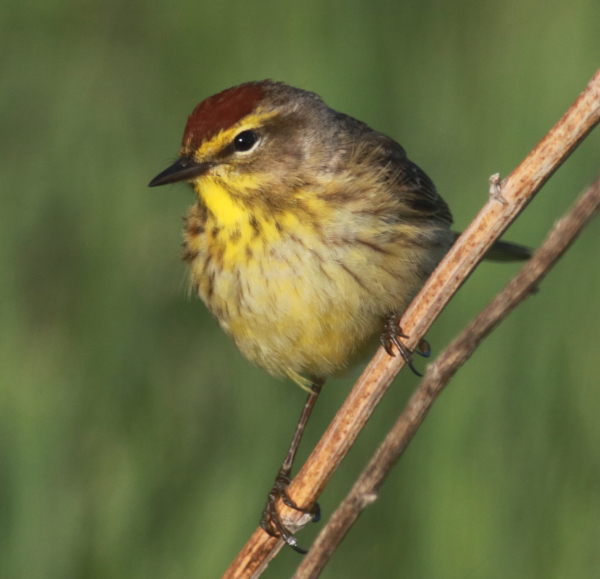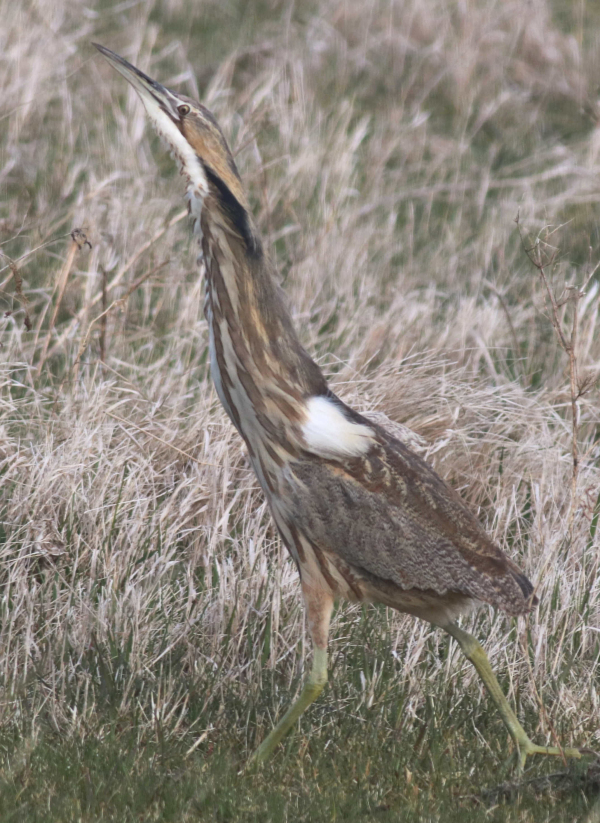
A surprise close encounter with a Palm Warbler provided a number of photo positions just a few feet away.

After a memorable photo session provided by a pair of Western Grebes that illustrates this week’s Bird Photography feature, another pair surprised Paul close to home Monday morning when they performed a “weed dancing” display.

An interesting series of interactions among bitterns resulted in a series of photographs this week, including this displaying male American Bittern.
|
Warblers continued to thrill me when I was surprised by the first Palm Warbler of spring. I even managed a couple long-range photos of it as it perched over a small pond. But in a flash it was gone and I was left with a few Yellow-rumps, which are always fun. I returned later, and almost immediately another Palm Warbler popped up from the grass. It flew to perch on a bare branch with an unobstructed background, providing a nice photo op. The colorful warbler flew out flycatcher style to snap up a small flying insect, then landed on a stalk of grass right beside me, but far enough away for my telephoto lens to focus on it – what luck and what fine photos it provided!
Palm Warblers have always been elusive for me; I don’t see many Palms, and when I do see one it’s usually alone or in the company of other species of warblers, or even native sparrows. I can think of two photos I’ve managed to take of Palm Warblers – one 11 years ago and another two years ago. So to get this great opportunity with fine light for several seconds at each of the two perches moments after arriving . . . talk about timing and luck, especially when the bird perched within a few feet of me with a pleasing green grass background.
Bitterns and Sandpipers
Two other groups of birds also provided exciting birding episodes Thursday afternoon: American Bitterns and Upland Sandpipers. After witnessing a male American Bittern displaying for a female for the first time last May, as I turned the corner down a favorite prairie road, I was excited to see a male bittern standing tall with its telltale white shoulder plumes extended; a small female was hidden a few steps away. I hoped they would provide another photo session as the male displayed.
While the male was not as intent as the bird I photographed last year, at one point after the female walked quite a distance before him, he made a short low flight toward her, slowing in midair to perform a fluttering wingbeat display with a low gurgling vocal before landing near her. That’s when I noticed a second male bittern keeping a low profile 120 feet away,” apparently shadowing the other two. The first male continued pursuing the female into the distance along the edge of the shallow marsh, so I continued on my drive, knowing I could check back on the bittern action on my return route.
About 45 minutes later, the female was nowhere in sight, but the males were facing off – not intensely, just one pressing the other to leave, following ever closer, and eventually forcing the second bird to fly; then following it in flight, which made for some good flight photos of these big birds.
Down the road, in between the bittern interactions, I crossed paths with a couple pairs of Upland Sandpipers, which yielded a few close photos of one individual. Upland Sandpipers are such unique birds of the northern prairie, but when I viewed a pair of them feeding on the edge of a wet meadow, I realized how similar-looking they are to Buff-breasted Sandpipers – a species I fantasize about photographing as they make a brief stop during their long migration from South America to an Arctic nesting territory. Hopefully, some day the fantasy will materialize – maybe next week! (ha-ha)
New Yard Sightings
I have really appreciated the ever-expanding variety of yard birds since May began. Regulars now include a rich mix of native sparrows – Harris’s Sparrows, White-throated, Chipping, and White-crowned, along with waves of Hermit Thrushes – sometimes three and four at a time. Rarely, but periodically, a Red-breasted Nuthatch stops by. Male American Goldfinches continued to brighten up my feeding station, and the first females arrived Tuesday (yesterday). In retrospect, Blue Jays and Pine Siskins appear to have vacated the area during the past week.
Rarer yard birds were drawn to the branches of the ash tree next to my feeding station, including a Least Flycatcher during mid-afternoon Thursday, and a Western Kingbird closer to sunset that was immediately followed by an active male Yellow-rumped Warbler. First thing as I started to leave home Friday morning, an American Kestrel dived into a few sparrows in falcon fashion just a few yards to the north, only to rise swiftly to continue on his morning raid farther east. Also Friday, the ground-oriented native sparrows were joined by a Brown Thrasher.
As a rain and wind storm began Saturday, I saw the flash of a Spotted Towhee fly up from the ground below my feeding station into the branches of the adjacent ash tree – nice bonus, but only a quick look. Sunday I was surprised by a Yellow Warbler searching through my front lawn, and the first bird I noticed as I slipped out the door Monday morning was a Yellow Warbler, perhaps the same one. But the biggest excitement at my feeding station this week was without question the first male Baltimore Oriole – Hooray! They are indeed special birds!
Avian Overview
A steady stream of new migrants continue to arrive, including a few pairs of Wilson’s Phalaropes, a Sora, a House Wren, a few scattered Snowy Egrets, and Great Egrets. Aside from first sightings, east of Bismarck I observed a true dark morph Swainson’s Hawk, a female, perched adjacent to a normally colored male.
An interesting pair of Swainson’s Hawks has been evident about six miles south of my office since arriving in the area April 20th. The big female is a beautiful rufous morph Swainson’s that makes her a marked bird for me to follow through the nesting season. Actually, this is the third spring I’ve enjoyed seeing this rufous female on the same territory. There is a good-looking nest that was built last year in a small tree grove located north of where the pair has been active, but I didn’t see the hawks show an interest in the site until about May 2nd, when the pair was soaring low above the nest site. Earlier that afternoon, I witnessed the male bringing a vole to the rufous female a half mile to the south, so it seemed they were getting more in tune with the nesting program. Finally, last week the pair began perching on the edges of the grove that contained the nest – nest building should be next on their agenda.
Drake Mallards and Northern Pintails have begun to band together, indicating some hens are incubating, or they are in advanced stages of egg-laying. Drake Ruddy Ducks are very actively displaying for females, and American Coots have been vying for territories. American Bitterns have been especially common again this year, and I see two to five bitterns during most drives I take through the area. You can hear their territorial calls, glug-kaglug, repeated at many marshes in the area. There have been more grebes too, especially Western Grebes, along with Pied-billed, Horned, and a few Eared Grebes.
Great Grebes!
After last week’s pheasant fight, of course I had to return to McKenzie Slough when I road-tripped to Bismarck last Wednesday. My timing was right again for fine lighting; all I needed were some cooperative birds. Eventually, a pair of Western Grebes were positioned in open, calm blue water – displaying together – what luck! I spent about 20 minutes with the pair as they interacted in some initial stages of their spring mating behavior.
I was a little surprised the pair displayed so close to me, and that they approached my position in the first place, but I’ve had that kind of luck lately, so rather than question it, I appreciated it. And McKenzie Slough came through again! The Western Grebes performed a series of mutual displays that provided an exciting collection of photographs, which are featured in the Bird Photography article toward the end of this issue. I also include one photo here of a pair performing a “weed dancing” display, which I observed just a mile north of home Monday morning. I’ve photographed Western Grebes displaying a few times before, but never in such close quarters as last Wednesday and Monday morn.
It’s always a thrill to have birds accept you, or ignore you, as they continue with their rites of spring. Certainly, I’ve been lucky in that regard the past few weeks! And I’m ready for more as spring migration leads into the nesting season. When the sun is lighting the northern prairie, I’m spending as much time as possible searching out new birds, new behaviors, and new photo opportunities – and I hope you likewise are taking advantage of these exciting weeks of May.
Article and photos by Paul Konrad
Share your bird sightings and photos at editorstbw2@gmail.com